Shichahai Park in Xicheng district, Beijing is quiet on a Thursday afternoon in early November. On a busier day, the Houhai Lake, which lies within the park, would be buzzing with water sports like paddle boarding, dragon boat racing and even the occasional kayak.
The swimmers, on the other hand, are there all year round, even during the height of winter.
According to the Chinese capital’s meteorological service, winter officially started in Beijing on November 3. However, after seven days, it still feels very much like autumn; the temperature is a pleasant 17 degrees Celsius, and autumn leaves can still be seen across the city, including in Shichahai.

Beijing, Houhai on a mid-November day. Image via That's/Alistair Baker-Brian
It won’t be long before all this changes.
By late December, water sports on the Houhai Lake will have made way for ice skating, sledding and what can only be described as ice bicycles.
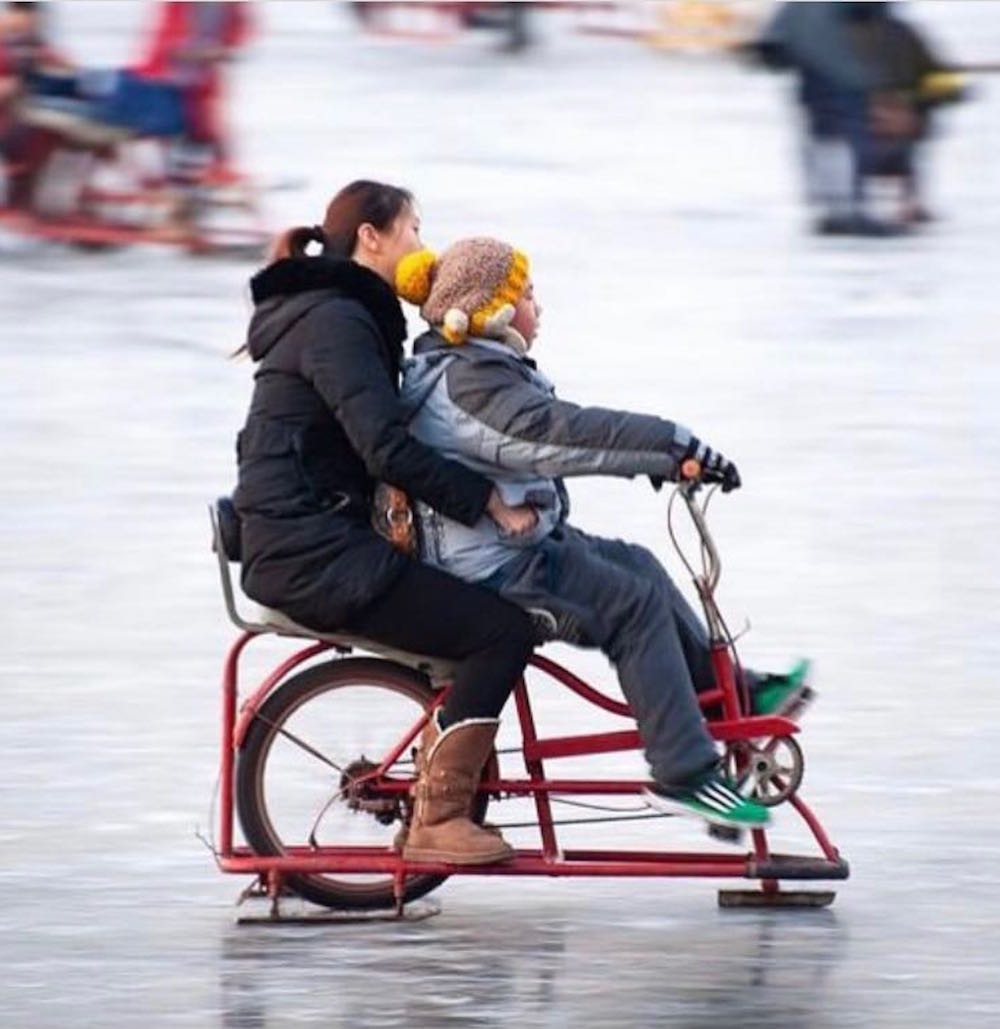
Fun on an ice bicycle at Houhai during winter. Image via Instagram/@greenpumpkindesign
The exception to this? The swimmers – they’ll find an unfrozen part of the lake in which to immerse their bodies in the bitter cold.
Beijing is one of many places across North China where bitterly cold winters are an inescapable reality. As far north as Heilongjiang province and as far west as Xinjiang Uyghur Autonomous Region, residents in cities, towns and villages have to brace themselves for temperatures that can consistently plummet well below zero.
Houhai Lake somewhat represents the more jovial side of winter in North China – friends and families enjoying ice skating, perhaps followed by a hearty hotpot.
Across North China, many areas become a winter wonderland – with everything from skiing and snowboarding to a simple frolic in the snow.
But, as you probably don’t need to be reminded, winter in North China can also bring its fair share of problems – dry and polluted air, high levels of chlorine in the water, etc. – problems which have been vastly reduced in scale and severity over the years thanks to the efforts of government and private enterprise.
Having spent a number of winters in North China ourselves – in both Beijing and Urumqi, capital of Xinjiang Uyghur Autonomous Region – we’ve seen wonders of winter and the more left-out-in-the-cold way of life.
However, there’s perhaps one thing we couldn’t be more sure about; we’re grateful to have spent winter in North China in the age of extensive central heating systems, and the age in which there are water filters, HEPA filters, down jackets and more.
As you’ll soon discover, winter in North China can be tough, bitter, beautiful, fun and just about everything else in between.
Where is North China Anyway?
To answer this question, one needs to be familiar with a particular geographical line.
The Qinling-Huai line is made up of the Qinling Mountains – stretching across Gansu, Shaanxi and Henan provinces – as well as the Huai River which originates in Henan province and flows through Anhui and Jiangsu provinces, before connecting with the Yangtze River in the city of Yangzhou.
Far from being a mere geographical divide, the Qinling-Huai line has defined modern China’s central heating policy – a policy which has remained in place since the 1950s, though there have been modernizations over the years.
READ MORE: Explainer: Why Beijing Gets Central Heating Yet the South is Left in the Cold
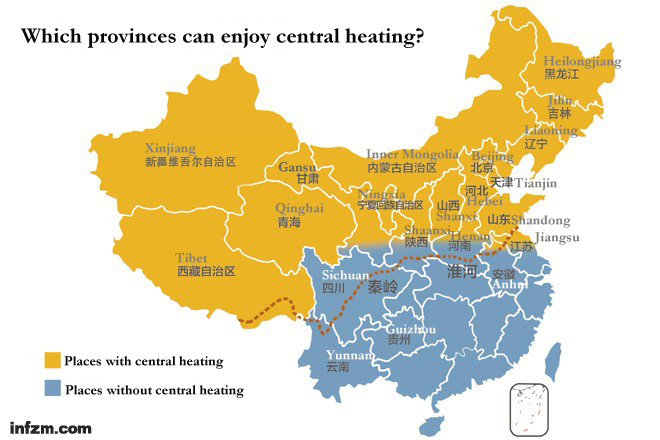
China's central heating divide. Image via infzm.com h/t CRI English
At that time, it was determined that most areas north of the line would be provided with central heating. That’s why in cities like Beijing, Tianjin, Shenyang, Hohhot, Urumqi and anywhere else in North China, you probably won’t feel cold indoors during wintertime.
Every year around mid-November, residents across North China await the announcement of gongnuan ri, or “central heating day.” Once switched on, the central heating system will run 24/7 until sometime around mid-March the following year.
In recent years, a debate has arisen about whether the central heating policy should continue to be centered around the Qinling-Huai line.
In 2010, China Daily published an article in which two experts offered their visions for the future of central heating. Jiang Yi, a professor at the School of Architecture, Tsinghua University argued that the Qinling-Huai line should still be used as the benchmark for central heating policy:
“People living just south of the geographical dividing line feel the harshness of winter as much as their northern neighbors. But there has to be some point of reference for the geographical division, or else the boundary will keep shifting southward until it reaches the South China Sea.”
He stated that the use of localized forms of heating would make more sense for places in South China.
Meanwhile, Deng Qingguang, a senior engineer specializing in heating systems stated the entire system needs an overhaul to make it more efficient. He agreed that building a central heating system for the entirety of South China is not necessary.
Fast-forward to 2022, and many areas south of the Qinling-Huai line have constructed their own targeted versions of central heating systems. Wuhan, Hefei, Changsha, Kunming and elsewhere all have some form of limited central heating, reports The Paper.
In March 2021, Sichuan provincial capital Chengdu installed its own central heating system. And, as recently as December 2021, Haiyan county in Jiaxing, Zhejiang province became the first place in South China to install a nuclear-powered central heating system.
There are also a small number of places north of the Qinling-Huai line which missed out on central heating over the years.
One of those places is Zhoukou city, Henan province. However, authorities have recently installed central heating systems in parts of the city, including in the city center.
Those of us who live in North China may take central heating for granted. Elsewhere, many of you will know all too well the struggles of keeping warm using air conditioning and space heaters; our colleagues based in Shanghai and Guangdong can relate.
A Winter Journey Through Time
Many of us can only imagine what life was like during winter in China’s northeast Dongbei region in the 1970s.
Someone who can recall exactly that experience is Li Tiefeng who was born in 1971 in Jilin city, Jilin province. Li lived in his home city until 1989 before moving permanently to Beijing.
He tells That’s about some of his childhood memories of winter in Jilin.
“At that time, we didn’t have central heating in our home. We lived in a single-story house and had to burn coal to keep warm.

Li Tiefeng in his home city of Jilin, 1995. Image via Li Tiefeng
“We had a stove which was connected to a huokang – a kind of bed built out of bricks which are kept warm by the stove. I would sleep on top of the huokang at night.”
In English, a huokang is best translated literally – a heated brick bed, something which Li explains was very common in Dongbei at that time, and which made for efficient use of heat.
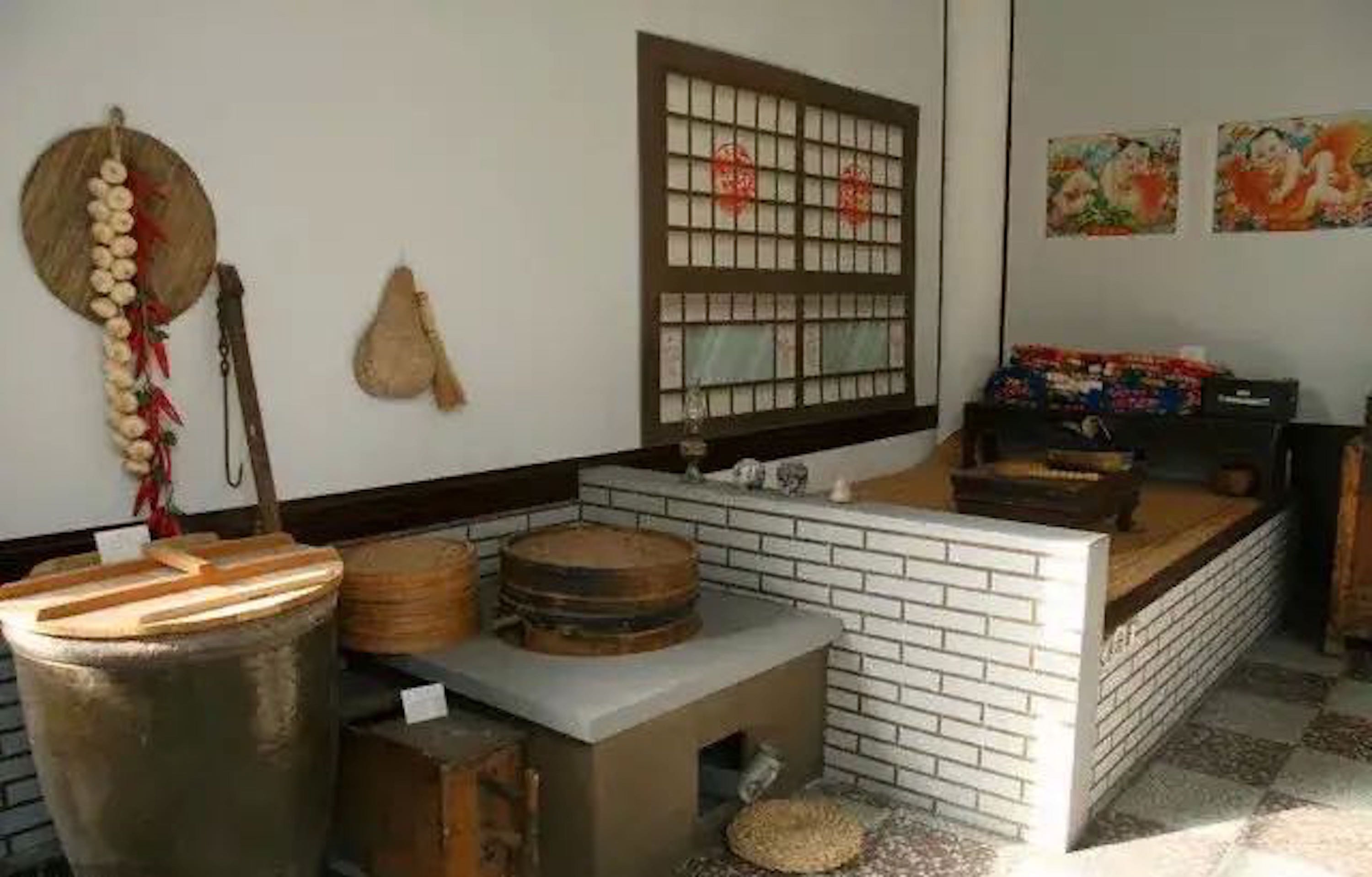
A typical huokang inside a home. Image via Weibo/@地抓熊老六
“The heat from the stove heats up the huokang and the room. We could also use the stove for cooking. So, the heat was not wasted.”
Another of Li’s vivid memories is that of food storage during the winter months.
“We had to store many cabbages before the winter came – hundreds of kilograms of cabbages. During winter, we would eat a lot of cabbage, carrots and potatoes – vegetables that are very easy to preserve during winter.
“At my house, we had a dijiao – a warm storage basement. We would put the cabbages, potatoes and carrots in there. I’m not sure if these still exist now.”
While winters in Jilin could be tough, Li also has plenty of fond memories.
“We always played on snow and ice – skating, etc. Close to the city of Jilin, we would go sledding on the snowy hills and mountains.”
Jilin’s winter scenery is certainly something to behold. Despite the temperatures which can drop below -20 degrees Celsius, the Songhua River – which runs through Jilin city – does not freeze during winter.
When the warm water from the river meets the cold winter air, ice crystals form on the trees – a unique natural phenomenon that makes Jilin well worth a visit.
It’s the kind of scenery that Li missed when he moved to Beijing in 1989 to study at university. One of the main differences he noticed is that lots of places in Beijing already had central heating installed, including his university.
We can’t help but notice the stark differences between Li’s experience of winter in Jilin and our own experience in Urumqi.
For Urumqi locals, winter was nothing to be swayed by. When heavy snowfall hit, residents in the Lujing Huayuan community – where we lived in the city’s New District – would layer up, grab a shovel and head outside to clear the snow.
And, they don’t let a little bit of snow bring the city’s schools and workforce to a standstill (except on one occasion when it was literally knee-height).
Like Li, we also have fond memories of winter in North China, particularly in Urumqi. We had the chance to explore a snow-capped Kazakh village in Nanshan, about an hour’s drive from Urumqi; and try snowboarding for the first ever time in the Tianshan Mountains.

Looking down a ski slope in Nanshan, located just outside Urumqi. Image via That's/Alistair Baker-Brian
One thing that doesn’t really stick in the memory is actually feeling the cold, especially having spent so much time indoors during winter where central heating is on 24/7.
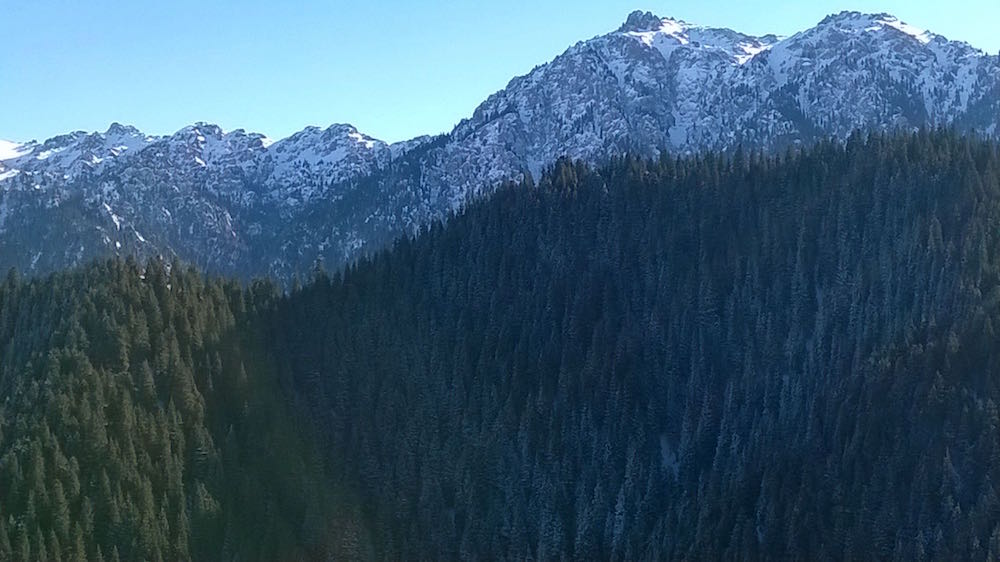
A view of the Tianshan mountains in Xinjiang. Image via That's/Alistair Baker-Brian
Someone who’s had more than his fair share of winter experiences in Urumqi is that of British expat Martin (a pseudonym for privacy reasons) who worked in the city as a teacher. He has since moved back to the United Kingdom.
Having spent a total of seven winters there, he has, in his own words, “seen a lot of snow.”
He acknowledges that there were challenging aspects during wintertime in the city.
“Finding taxis was always difficult before ride-hailing apps became commonplace. I imagine that’s a lot easier now. Cabin fever was also an issue as the really cold temperatures in January and February meant that you could only spend about 20 minutes outside at a time.
“I remember watching a lot of TV series during the winters!
“Shedding winter outer layers before the 26 degrees Celsius indoor temperatures in people’s homes was also a constant challenge!”
Martin adds that while heavy snowfall could make his commute to work a little less convenient, he notes that Xinjiang people have “an impressive ability to ignore the winter and carry on with their lives.”
“Despite the freezing temperatures and snow, social lives didn’t suffer too much. As expats, we would go to bars a couple of times a week, and we regularly went snowboarding in Nanshan.”
Martin is certainly grateful for having lived in Urumqi, if anything because the experience made him stronger.
“In general, I think living in a place where the climate is challenging is good for developing resilience. Everything becomes more challenging, even simple things like taking a car to meet with friends. But we make it work.”
Sometimes we wonder what it’d be like to live in Urumqi 30-40 years earlier. Would we be firing up a huokang every time we arrived home?
Coughs, Chlorine and Contaminated Air
That’s right. Winter in North China is not all skiing, skating and snowball fights.
With winter comes an increased burning of coal and other fossil fuels, resulting in more harmful pollutants in the air including PM2.5 particles.
However, that’s not to say there hasn’t been recent success in reducing air pollution. The Chinese capital used to be notorious for smog, especially during winter. In late 2019, Beijing left the world’s top 200 most polluted cities list.

Image via Greenwave/David Wang
Someone who knows all about helping people overcome health problems during winter is David Wang, general manager of Greenwave – an environmentally conscious company helping to provide clean air and energy solutions to individuals, households and businesses for over 10 years.
READ MORE: Greenwave's David Wang on COVID-19 and Winter Health Problems in Beijing
Greenwave’s products include water filters for faucets and shower heads, drinking water purifiers, air purifiers, humidifiers, dehumidifiers and more.

The Alatai Water Filter, one of Greenwave's signature products. Image via Greenwave/David Wang
The company serves customers across the Chinese mainland. In North China, Wang tells That’s that most customers tend to be in Beijing, Tianjin and Dalian, though the customer base is not limited only to these cities.
What are the main winter problems that Wang and Greenwave deal with?
“Dryness in homes, especially in North China, is a big problem. This occurs when the central heating system is switched on. The dryness can make people feel uncomfortable. It can cause you to cough more, and to have an itchy throat. For some people, it might be necessary to take medicine and even visit the doctor.
“When it comes to dryness, we suggest that customers consider the balance of the humidity indoors. It might be necessary to get a humidifier.”
Water is another thing to watch out for during winter. Levels of chlorine can increase. Meanwhile, there’s another problem that Wang says he’s been watching out for recently.
“I’ve tried to get my team to write something about PFAS (polyfluoroalkyl substances; linked to harmful health effects in humans and animals); recently, high levels of PFAS have been reported from the United States and some European countries.”
The American Environmental Protection Agency (EPA) recently announced tighter regulations of PFAS levels in water after an independent analysis found a “shocking level of contamination” in parts of the country.
Towards a Warmer Future?
Those growing up in North China nowadays will likely have little idea of winter hardships from years gone by – no huokang and no need to store vegetables as winter hits.
Winter problems persist, of course. But, with pollution levels dropping in Beijing and elsewhere, as well as innovative companies like Greenwave on hand to offer customer-oriented solutions, winters in North China can surely only get easier.
Perhaps, even younger people south of the Qinling-Huai line will know little of the harsh winter cold.
Li opines that areas in South China should be able to introduce targeted central heating where necessary. He recalls traveling to southern cities without central heating where the humidity would make the cold worse during winter months.
Coincidentally, Wang is from Bengbu – a city in Anhui province that lies on the Qinling-Huai line. He agrees that central heating can be necessary for parts of the south.
“In Shanghai during the winter, I know, having lived there, that it can be cold! We have to use the air conditioning to keep warm.”
Regardless of the path that parts of South China choose to take, no one can deny that in the North, most people have probably never had it so good during winter.
For many, the cold season in recent years might not so much conjure images of hardship and bitterly low temperatures, but rather images of ice skating on Houhai Lake, winter sports and heartily warm meals with family and friends – at least, those are the images we’d most like to have.
Interviews have been edited for clarity and brevity.
[Cover image via That's/Alistair Baker-Brian]
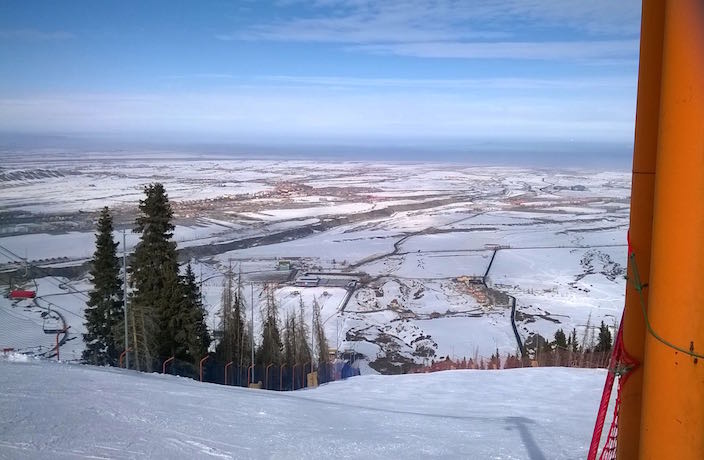






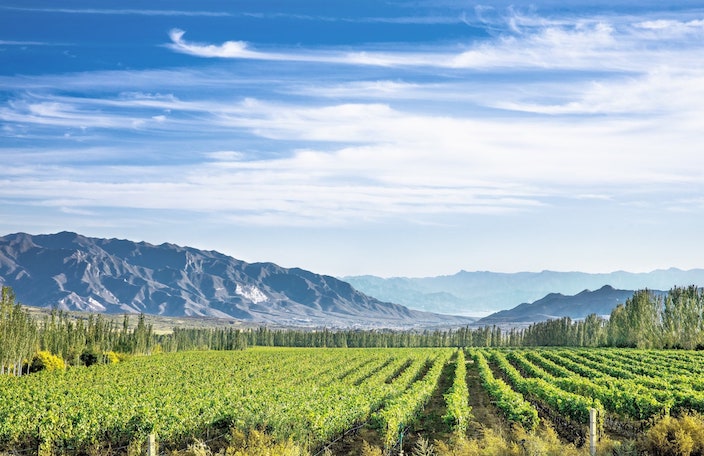














0 User Comments